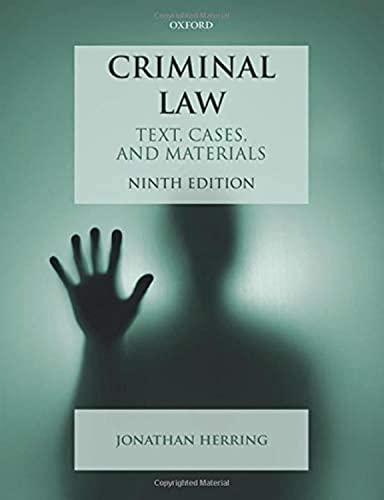Question
REPLY IN ONE SHORT PARAGRAPH OF WHAT YOU THINK OF THIS DISCUSSION DO YOU AGREE OR DISAGREE AND WHY? Explain what a challenge for cause
REPLY IN ONE SHORT PARAGRAPH OF WHAT YOU THINK OF THIS DISCUSSION DO YOU AGREE OR DISAGREE AND WHY?
Explain what a challenge for cause and a peremptory challenge are. Provide an example of both.
Explain the purpose of a directed verdict, when does it occur and why.
Explain the function of the Court of Appeals.
A challenge for cause is when counsel tries to remove a potential juror with reason, something makes them unsuitable which brings into question that they are competent and/or fair and impartial regarding this case, and that the judge then decides on. A peremptory challenge is when counsel can strike a juror without giving a reason (as long as it's not because of gender or race) as many times as the jurisdiction allows. An example of challenge for cause might be that counsel calling for a juror to be removed because he was in the defendant's graduating class. An example of peremptory challenge is counsel using one of their six strikes to remove a juror they felt might not be totally receptive to their line of defense, but is otherwise a suitable juror.
A directed verdict is for when one side has not sufficiently proven their argument and the other asks for the judge to make a verdict then and there so the court proceedings don't need to take any more time. A directed verdict for the defense happens when the plaintiff has finished their case without providing sufficient evidence and a directed verdict for the plaintiff happens after defense has finished presenting their witnesses without properly refuting the plaintiff's claim. This happens at those points because if one side presents all their evidence and witnesses without actually proving their case or even that there is a need for further deliberation, then there's no need to spend the additional money and time needed to go through the rest of the trial process.
The Court of Appeals reviews cases in the lower courts to correct legal error and/or to clarify the law in certain cases, looking at the proceedings in the previous trial and the law itself rather than the actual events within the case from the lower court. The Court of Appeals can then affirm the judgement, reverse the judgement, or remand the case with directions depending on how it finds.
Step by Step Solution
There are 3 Steps involved in it
Step: 1

Get Instant Access to Expert-Tailored Solutions
See step-by-step solutions with expert insights and AI powered tools for academic success
Step: 2

Step: 3

Ace Your Homework with AI
Get the answers you need in no time with our AI-driven, step-by-step assistance
Get Started


